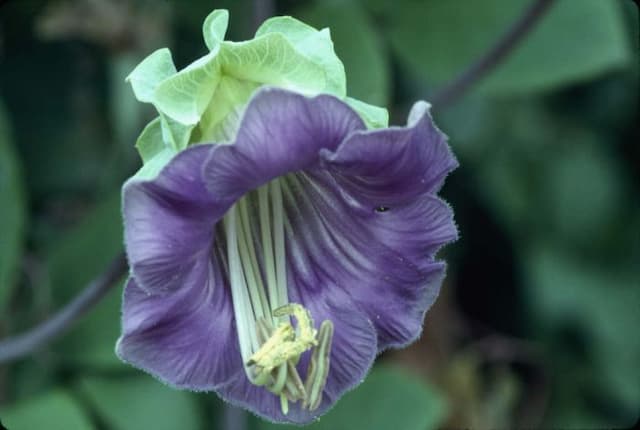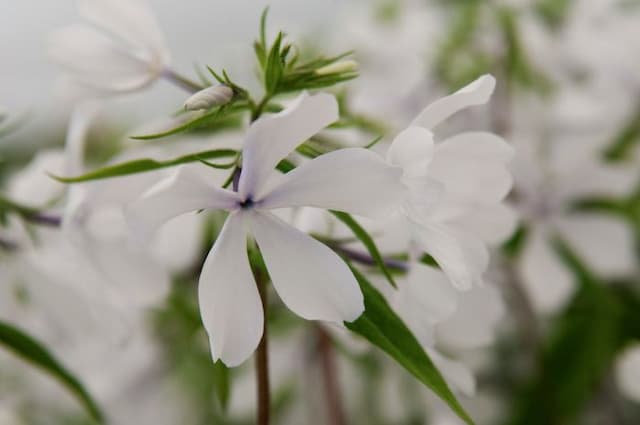Garden Phlox Phlox paniculata 'Norah Leigh' (v)

ABOUT
Norah Leigh phlox is a charming perennial known for its striking variegated foliage and showy blooms. The leaves of this phlox are eye-catching, with creamy-white edges bordering a vivid green center, providing a striking contrast that adds visual interest even when the plant is not in bloom. As the season progresses, Norah Leigh phlox produces large clusters of flowers that can range in color from pale pink to lavender, with a delicate fragrance that adds another layer of appeal to the garden setting. Each individual flower within the cluster has five rounded petals that spread outwards from a deeper colored center, creating a classic and romantic appearance typical of phlox flowers. The variegated leaves and the soft-hued blossoms together create a lovely display that can brighten up garden borders, attract butterflies, and serve as excellent cut flowers for indoor arrangements.
About this plant
 Names
NamesFamily
Polemoniaceae
Synonyms
Garden Phlox, Summer Phlox, Perennial Phlox, Fall Phlox
Common names
Phlox paniculata 'Norah Leigh'.
 Toxicity
ToxicityTo humans
Garden Phlox is generally considered non-toxic to humans. There are no well-documented cases of poisoning from Garden Phlox, and it is not known to contain any toxic substances that would cause harm if ingested in small quantities. However, as with any plant, individual allergies or sensitivities could potentially cause mild irritation or discomfort if the plant is ingested or handled without gloves.
To pets
Garden Phlox is also generally regarded as non-toxic to pets. It does not appear on lists of poisonous plants for animals such as dogs and cats, and there appears to be no significant risk of poisoning if pets come into contact or accidentally ingest this plant. Nonetheless, monitoring pets and preventing them from eating any plants is always advised, as individual animals might have unique sensitivities or reactions.
 Characteristics
CharacteristicsLife cycle
Perennials
Foliage type
Deciduous
Color of leaves
Variegated
Flower color
Pink
Height
2-4 feet (60-120 cm)
Spread
2-3 feet (60-90 cm)
Plant type
Herb
Hardiness zones
4-8
Native area
North America
Benefits
 General Benefits
General Benefits- Attractive Flowers: Phlox paniculata 'Norah Leigh' offers a display of variegated foliage and fragrant, showy flowers that enhance the aesthetic appeal of gardens and landscapes.
- Pollinator Friendly: This variety of garden phlox attracts bees, butterflies, and other pollinators, supporting biodiversity.
- Long Blooming: It has a long flowering season, providing color and interest in the garden from mid to late summer.
- Easy to Grow: The plant is relatively easy to care for, requiring minimal maintenance once established.
- Versatility: It can be used in a variety of garden settings, including borders, cottage gardens, and as a background plant in mixed beds.
- Cut Flower Use: The blooms make excellent cut flowers for arrangements, bringing the garden's beauty indoors.
- Hardiness: This phlox is hardy in a range of climates, making it suitable for growth in many regions.
- Disease Resistance: 'Norah Leigh' is noted for having better resistance to powdery mildew than some other varieties of garden phlox.
- Structural Interest: When not in bloom, the variegated leaves of Phlox paniculata 'Norah Leigh' add a textural and color contrast to the garden.
 Medical Properties
Medical PropertiesThis plant is not used for medical purposes.
 Air-purifying Qualities
Air-purifying QualitiesThis plant is not specifically known for air purifying qualities.
 Other Uses
Other Uses- As a natural dye source: The flowers of garden phlox can be used to create a gentle, natural dye for fabrics or artistic purposes.
- In crafting potpourris: The fragrant blooms of garden phlox can be dried and added to potpourris for a pleasant scent in the home.
- Photography subject: Garden phlox's vibrant colors and patterns make it a popular subject for photographers and botanical artists.
- Educational tool: It can be used in school projects or educational gardens to teach about pollination and plant biology.
- Floral arrangements: Fresh or dried garden phlox flowers are often used in floral arrangements and bouquets.
- Garden design: Garden phlox is used in moon gardens due to its light foliage and flowers that stand out in the evening light.
- Erosion control: Planted in masses, garden phlox's root system can help stabilize soil and prevent erosion.
- As a colorful mulch alternative: When trimmed, the foliage and spent flowers of garden phlox can add a touch of color to garden beds as a decorative mulch.
- Culinary decoration: Although not commonly consumed, the vibrant flowers can be used to adorn cakes and desserts as an edible garnish after proper preparation.
- Frost indicator: The first fall frost can sometimes be predicted by observing the wilting of garden phlox's delicate flowers.
Interesting Facts
 Feng Shui
Feng ShuiGarden Phlox is not used in Feng Shui practice.
 Plant Symbolism
Plant Symbolism- Harmony - Phlox paniculata symbolizes harmony due to their clustered flowers that represent unity and the blending of hearts.
- Sweet Dreams - The common name "Phlox" is derived from the Greek word phlox meaning flame or fire which in flower symbolism can indicate a fervent wish for the receiver to experience sweet dreams and peace of mind.
- Agreement - The long blooming period and the orderly nature of the garden phlox blooms represent an enduring agreement or consensus among people.
- Proposal - In the language of flowers, phlox can signify a proposal or an offer that awaits acceptance, reflecting the plant's inviting and showy nature.
 Water
WaterGarden Phlox should be watered deeply and thoroughly, ensuring moisture reaches the roots, about once a week depending on weather conditions. During hot or dry spells, watering frequency should increase to twice a week. Provide about one inch of water each time, which is roughly equivalent to 0.6 gallons per square foot every week. Ensure the soil is moist but not soggy to prevent root rot. Regular watering is particularly crucial during the first growing season to establish a deep, extensive root system.
 Light
LightGarden Phlox thrives in full sun to partial shade, with at least six hours of direct sunlight each day. It prefers a location where morning sun can dry the dew on the leaves, reducing the risk of disease. However, in extremely hot climates, some afternoon shade can help prevent stress and wilting from intense sunlight.
 Temperature
TemperatureGarden Phlox is hardy and performs best in areas with a temperature ranging from 60 to 85 degrees Fahrenheit. It can survive minimum winter temperatures down to -30 degrees Fahrenheit. The ideal growing temperature for robust blooms and healthy foliage is within the 60 to 70 degrees Fahrenheit range.
 Pruning
PruningGarden Phlox should be pruned to promote vigorous growth, improve air circulation, and reduce the risk of fungal diseases. Deadheading spent flowers encourages reblooming and prevents self-seeding. Cut back the stems by one-third to one-half after flowering to maintain a compact form. The best time for pruning is late winter or early spring before new growth begins.
 Cleaning
CleaningAs needed
 Soil
SoilGarden Phlox 'Norah Leigh' thrives best in a soil mix that is rich in organic matter, moist but well-draining, with a pH ranging from 6.0 to 7.0. To create the best soil mix, blend garden loam, compost, and peat moss or coarse sand to ensure fertility and proper drainage.
 Repotting
RepottingGarden Phlox 'Norah Leigh' is a perennial plant and typically does not require repotting as it is not grown in containers. Instead, division of clumps every 3-5 years in the garden helps to maintain vigor and prevent overcrowding.
 Humidity & Misting
Humidity & MistingGarden Phlox 'Norah Leigh' prefers moderate humidity levels but is quite adaptable to average outdoor conditions. It fares well in the humidity levels typically found in temperate gardens without the need for additional adjustment.
 Suitable locations
Suitable locationsIndoor
Grow in bright light, ensure good air circulation.
Outdoor
Plant in sun/partial shade, enrich soil, mulch.
Hardiness zone
4-8 USDA
 Life cycle
Life cycleGarden Phlox 'Norah Leigh' begins its life as a seed, germinating in spring when soil temperatures warm up. The seedling emerges and develops into a vegetative state, with leaves and stems growing progressively through the active growing season. As the plant matures, it forms a clump with its root system expanding and becoming more established. The plant reaches its flowering stage in mid to late summer, producing clusters of variegated pink and white flowers that attract pollinators. After blooming, the flowers develop into seed heads, and once the seeds are mature, they are dispersed, completing the reproductive cycle. During the winter, Garden Phlox 'Norah Leigh' becomes dormant, with the top growth dying back and the plant surviving underground through its root system until the next spring.
 Propogation
PropogationPropogation time
Early Spring
Phlox paniculata 'Norah Leigh', also known as Garden Phlox, is commonly propagated by division. The best time for dividing Garden Phlox is in early spring or fall, when the plant is not in active growth. To propagate by division, dig up the entire plant, being careful to keep as much of the root system intact as possible. Gently separate the crowns by either teasing them apart with your hands or using a sharp knife if necessary. Each division should have at least two or three shoots and a portion of the root system. Replant the divisions immediately at the same soil depth as the original plant, spacing them about 18 inches to 2 feet (approximately 45 to 60 centimeters) apart to allow for adequate air circulation and growth. Water the new divisions thoroughly to help establish them.









